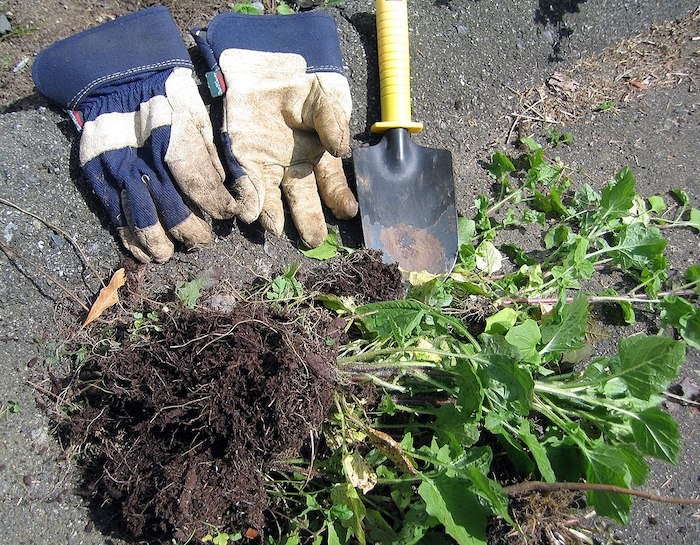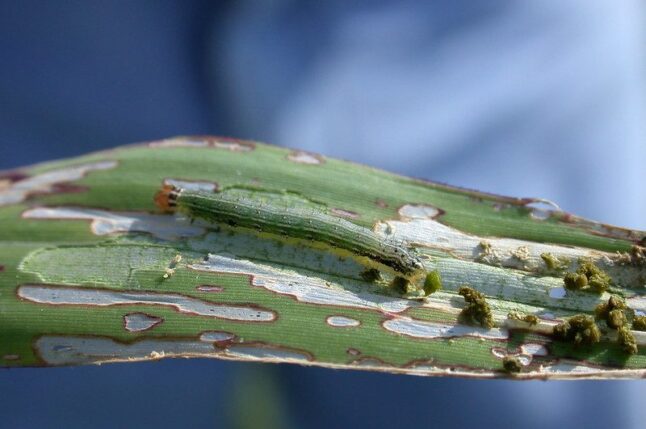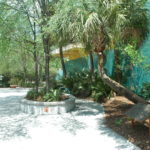
Tampa Bay summers last from April to September. They are hot and moist – a mix that helps vegetation thrive while also making things complicated for lawn owners. Everything is abundant, from rainfall and sunlight to pests, fungi, and weeds. The secret to healthy turfgrass is keeping it all in balance and doing things on time.
Here are 9 summer lawn care tips for your Tampa lawn to help you do all the right moves for green, thick grass.
In this article:
- Mow Regularly to Maintain a Healthy Grass Height
- Fertilize Responsibly to Avoid Water Contamination
- Irrigate With an Eye on the Tampa Weather Forecast
- Consider Rainwater Harvesting
- Hurricane-Proof Your Tampa Bay Lawn
- Reseed Warm-Season Grass Until July
- Keep Tampa Lawn Weeds Under Control
- Prevent and Control Take-All Root Rot in the Humid Tampa Weather
- Protect the Turfgrass from Tampa Lawn Pests
1. Mow Regularly to Maintain a Healthy Grass Height

Summer heat in Tampa means averages of 80°F and peaks of over 90°F. Even warm-season grasses are a bit heat-stressed. One way to help them is by mowing correctly. It’s easy. All you need to do is follow these 4 principles:
- Mow the grass taller. Cut at the maximum recommended height or about 0.5 inches over. Taller grass shades the soil and limits water evaporation. It also promotes thicker and deeper roots, improving drought tolerance and grass resilience to common lawn pests.
- Only cut ⅓ of the height. Removing more slows healing and exposes the grass to fungal diseases and summer heat stress.
- Keep the mower blades sharp. A clean cut heals faster.
- Don’t mow while the grass is wet. It’s harder for the lawn mower to cut the grass, and the plants are more vulnerable to fungi.
Here are the recommended mowing heights for the most common types of grass in the Tampa Bay landscape:
| Turfgrass Species | Optimal Mowing Height (inches) | Mowing Frequency (days) |
| Bahia | 3.0 – 4.0 | 7 – 17 |
| Bermudagrass | 0.5 – 1.5 | 3 – 5 |
| Carpetgrass | 1.0 – 2.0 | 10 – 14 |
| Centipedegrass | 1.0 – 2.0 | 10 – 14 |
| St. Augustinegrass | 3.5 – 4.0 | 5 – 14 |
| Zoysia | 1.0 – 2.0 | 10 – 14 |
| Seashore paspalum | 1.0 – 2.0 | 5 – 7 |
| Buffalograss | 2.0 – 3.0 | 7 – 10 |
2. Fertilize Responsibly to Avoid Water Contamination

According to the University of Florida, you should avoid fertilizing during summertime. Heavy rainfall often comes in the Tampa Bay area from June to September. It converts spread lawn fertilizer into toxic runoff that gets into the groundwater, contaminating rivers and bays up to the Gulf of Mexico.
In Manatee and Pinellas counties and the City of Tampa, fertilizers with nitrogen and phosphorus are banned from June 1 to September 30. So, how can you keep the grass green and thick during summer while protecting the water?
Here are a few practical eco-friendly fertilizing tips for the Tampa Bay area:
- Test and improve soil pH as part of the winter lawn care schedule and fertilize correctly in the spring. This way, you improve nutrient absorption and can reduce the need for summer fertilization.
- After mowing, leave the grass clippings on the lawn. They are an efficient, natural, and safe nitrogen source, perfect during the growing season.
- Add some iron for greener grass. It keeps turf healthier without stimulating excessive growth.
- Choose a slow-release fertilizer with potassium and little to no phosphorus and nitrogen (fertilizers with “0” as the first two numbers on the label, for example, 0-0-6).
- Fertilize in May or early June before the wet season starts.
- Don’t fertilize before heavy rain to prevent fertilizer from contaminating the stormwater runoff.
- Never fertilize within 10 feet of a body of water to reduce the chances of contamination.
3. Irrigate With an Eye on the Tampa Weather Forecast

A healthy, beautiful lawn needs 1 inch of water per week. Depending on the amount of rainfall in Cigar City, this may include:
- Only irrigation
- Irrigation and rainfall
- Only rainwater
From June to September, the monthly amount of rain ranges from 7 to 9 inches per month, and overwatering can be an issue. To keep your lawn healthy during summer, follow these three easy watering tips:
- Turn off the sprinkler system when it rains.
- Check if the soil needs water before turning the sprinklers on.
- Install a rain sensor to do these things for you automatically.
4. Consider Rainwater Harvesting

During the wet season, homeowners in the Big Guava can reduce irrigation costs by capturing rainfall. Collecting stormwater has multiple benefits:
- It limits runoff.
- It reduces water pooling on the lawn.
- It offers an alternative irrigation source during water restriction periods.
This practice is called rainwater harvesting and is part of the Florida-friendly landscaping program.
To make it happen, you need:
- Rain barrels or a tank to collect water from the home’s roof and gutters.
- A water filter (optional)
- A sprinkler system to simplify irrigation
You can learn more about rainwater harvesting at the workshops organized by the University of Florida local extensions and about restrictions and incentives in our state-by-state rainwater harvesting guide.
5. Hurricane-Proof Your Tampa Bay Lawn

June to November is hurricane season in the Tampa Bay area, from St. Petersburg and Clearwater to Cigar City. To lower the damage of heavy stormwater and high winds on your grass, make your lawn hurricane-resistant by:
- Correcting any low spots on your lawn. Add topsoil, cover with pavers, or make it a rain garden if it’s a larger area. Lawns with water pooling zones are more prone to rot and fungal diseases, so you must minimize or eliminate them.
- Ensuring good drainage. If sticking a screwdriver into the ground is hard, aerate the lawn. Install a French drain or a small pond to collect excessive stormwater.
- Replacing concrete walkways with pavers, which increases the area that can absorb rainwater.
6. Reseed Warm-Season Grass Until July

A dense lawn is more resilient to drought and more efficient in preventing local weeds from emerging. If you observe thinned areas on your lawn, consider overseeding or adding sod.
The best time to do this in the Tampa Bay area is from April to July. This way, the new growth has an entire season to develop, and it’s more resilient to lower temperatures during winter.
There’s also an exception. Thinning turf under the canopy of Tampa shade trees can’t be solved by overseeding since most warm-season grasses need full sun to thrive. It’s better to consider a native ground cover like the beach sunflower, ferns, or the railroad vine for shaded areas. Another option is spreading decorative mulch.
7. Keep Tampa Lawn Weeds Under Control

The hot and humid summer days make your Florida lawn fair game for perennial and summer annual weeds.
Perennial weeds come back year after year and multiply from seeds and vegetative parts. This makes them harder to remove. Among the most common perennial weeds that can thrive in your Tampa Bay lawn from June to September are:
- Broadleaf plantain
- Dandelion
- Dollar weed
Summer annual weeds only live a year. They emerge in the spring, as soon as the weather warms up, grow, flower, and die the same year. If you applied pre-emergent herbicide in early March, you shouldn’t have too many on your lawn. You can remove what has survived by hand or apply post-emergent herbicide. Among the most common summer weeds to look for during summer are:
- Crabgrass
- Goosegrass
- Spurge
- Florida pusley
- Doveweed
Summertime is also a perfect moment to stop winter annual weeds from emerging. In August and early September, apply a pre-emergent herbicide. It will prevent weeds like chickweed, henbit, hop clover, wild geranium, and annual bluegrass from taking over your lawn in the winter.
8. Prevent and Control Take-All Root Rot in the Humid Tampa Weather

Hot and muggy summer months expose your lawn to vile fungal diseases. The most aggressive is take-all root rot. Triggered by high rainfall and thriving in stressed turfgrass, it damages the root system. This prevents the plants from obtaining nutrients and water from the soil.
Once infected, your Tampa lawn develops yellow to light brown patches. Roots become short, black, and rotted. Plants die, thinning the lawn. Once the symptoms appear, it’s more challenging to control the disease. Here’s what you can do to prevent it:
- Apply preventive fungicides about a month before you usually see infection signs on your lawn. Continue once a month until the rainy season is over.
- Mow the lawn at the correct height. Never cut more than ⅓ of the blade.
- If you fertilize with nitrogen, always use a slow-release nitrogen balanced with equal potassium.
When the disease is active, apply foliar feeding with all the necessary nutrients in small amounts. Don’t apply lime or herbicides.
9. Protect the Turfgrass from Tampa Lawn Pests

Some damage done to your beautiful Tampa lawn that seems fungal or drought-related can be caused by lawn pests. Among the most common you can expect a visit from during summer are:
- Tampa lawn grubs are the C-shaped larvae of various scarab beetles, including the Japanese beetle. During summer, they chow down on grassroots right under the soil surface, making grass wilt and brown and eventually die.
- Chinch bugs are tiny black bugs with white wings that suck the grass blades dry and leave a toxin that kills the plant. The affected grass turns yellow and reddish-brown hues.
- Mole crickets tunnel through the soil, damaging grassroots and eating grass shoots. Infested lawns begin to show yellowing and browning patches and visible thin mounds.
- Armyworms love Bermudagrass and feed on the grass foliage, leaving bare patches on your lawn.
The best way to keep pests under control is to keep the lawn healthy and address the infestation fast. Here are three essential summer pest control tips to remember:
- Check the lawn for symptoms every 7 to 10 days in the summer. Catching the infestation early is vital.
- Apply only slow-release fertilizer and in small amounts to avoid excessive growth. Overfertilization attracts sap-feeding insects.
- Keep the thatch layer at a minimum. Thatch is an excellent habitat for chinch bugs and turf caterpillars. It also chemically ties up insecticides, reducing their effectiveness.
FAQ About Summer Lawn Care in Tampa, FL
Look for a summer feeding fertilizer. They’ll typically be low in nitrogen and phosphorus to avoid toxic leaching due to heavy rainfall.
Water restrictions in effect year-round in Florida limit irrigation to twice a week. During summer, consider the amount of water rain provides and only water when necessary.
To avoid fertilizing during the wet season, apply lawn fertilizer in mid-March and mid-April. Make the second application from April to June, 6 to 8 weeks after the first.
Enjoy a Thick, Green Tampa Lawn All Summer Long!
Keeping your lawn healthy in the subtropical, damp Tampa Bay summer can be time-consuming. Your yard suddenly becomes green heaven: an irresistible attraction for lovely butterflies and ladybugs but also nasty pests, fungi, and weeds. Watering is sometimes a gamble, and fertilizing should be way simpler.
The lush, thick grass you get as a result is definitely worth the work, but there’s an easier way. Go with professional lawn care services. Hire a trustworthy lawn care company in Tampa and enjoy a beautiful, dense lawn all summer long. No sweat, no worries. Just joy and green!
Main Photo Credit: Tampa FL Hyde Park Hist Dist12c / Ebyabe / Wikimedia Commons / CC BY-SA 3.0





